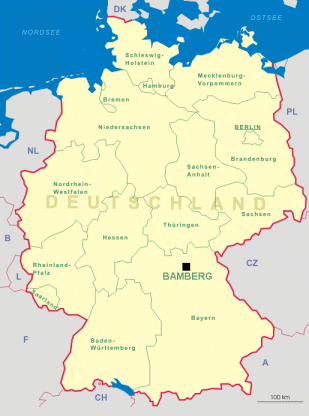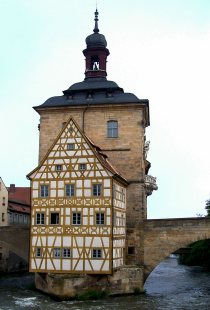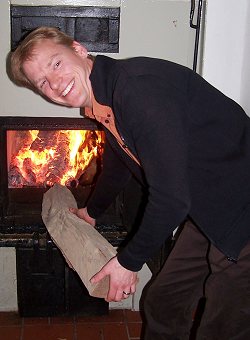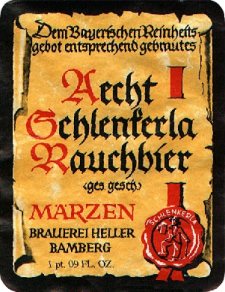 |
 |
|

|
|

|
 |
home
about
Protz
features
A-Z
books
|
|
Protz:
features
reviews
tastings
news & events
books
|

| |
Bamberg Part I - Beer Paradise
by Willard Clarke, 09/07
If you are searching for Beer Paradise, there�s no need to wait until you fall off your bar stool � just head for Bamberg. This city of 70,000 people in Franconia, upper Bavaria, has 11 breweries and a vast collection of inns and taverns in which to enjoy their brews.
The beers include fascinating examples of Rauch or �smoke beer� made from malt roasted over beech wood fires. The method was once widespread in Europe and the British Isles until wood was replaced by coke in the 19th century. A visit to Bamberg enables you not only to drink amazing beers in superb inns but also to see at first hand how beer was made centuries ago.
At the same time you can drink in some astonishing history, culture and architecture. Bamberg is a UNESCO World Heritage site and as you wander the narrow, winding streets you find at every turn stunning examples of medieval half-timbered buildings with Baroque and Renaissance styles for good measure.
|
|

|
The cathedral and Prince-Bishops' palace were built in the 13th century from local sandstone: the cellars and caverns left behind from the excavations were used to store perishables, including beer. The Benedictine monastery of St Michael looms above the city. It once had its own monastic brewery, which is now a brewing museum.

|
|
The standout building is the Old Town Hall, part Baroque, part half-timbered, with the medieval section perched on a sandbank above the rushing, foaming river Regnitz. The building�s precarious position is due to the refusal of the ruling Prince-Bishop to give the citizens more solid land on which to erect their first attempt at local democracy.
Bamberg is steeped in beer. The first licence to brew was granted in 1122 and the city�s own Reinheitsgebot or Purity Law � which permits only the use of malted grain, hops, water and yeast -- predates the Bavarian royal
family�s similar edict of 1516 by 26 years. In the early 19th century, Bamberg had 65 breweries when the population was just 20,000. The number of artefacts in the city � storage cellars, chimneys and lofts where malt was
dried � suggests than in medieval times there were possibly hundreds of tiny house breweries using communally-owned brewing vessels, passed from home to home.
|
The best known of Bamberg's breweries is Heller. Its fame is due to the fact that it exports its smoke beer far and wide, and also serves it on draught in the celebrated Schlenkerla tavern in the city centre on Dominikanerstrasse. The curious name of the pub stems from the fact that an ancestor of the Trum family that owns the brewery walked with a limp and was known in the local dialect as "the Schlenkerla" or limping man. It has added a new term to the vast lexicon of euphemisms for the state of inebriation: "I was well Schlenkerlared last night".
Heller has been brewing since 1678. The brewery was originally based in the tavern but moved in 1936 to a more spacious site in the nearby Stephansberg district. The young proprietor, Matthias Trum, representing the sixth generation of the family to run the company, bubbles over with enthusiasm for the traditions he proudly maintains.
Heller is the only remaining Bamberg brewery to use 100% smoke malt. Matthias led the way to the kiln where his malted barley is cured or gently roasted. Beech wood logs cut from the surrounding forests are stored alongside the kiln. Matthias opened the door of the kiln, disclosing a red, roaring blaze within. He added some fresh logs to maintain the correct temperature.
Matthias uses locally grown barley malt and Hallertauer hops from fields near Munich. The floral, piny and herbal hop aromas and flavours balance the extreme smokiness, Matthias says. The local water,
he adds, is very hard.
His brewhouse is based on two simple vessels - a mash kettle and a lauter. The mash of grain and pure hot water is transferred for filtration to the lauter and the clear wort or sugary extract then returns to the first vessel, where it is vigorously boiled with hops. The hopped wort is fermented for a week and then transferred to the lager cellars beneath the brewery.
|
|

|
Matthias took me down steep and perilous stairs to the cool cellars beneath the brewery. He has 14 small, horizontal lagering tanks where the 5.1% Aecht (Original) Schlenkerla Rauchbier is stored for two months. M�rzen (March) and strong Bock versions, lagered for three months, are also brewed.
It�s often thought that lagering or cold storage of beer developed in the 19th century when refrigeration was introduced. Carl von Linde, who invented the first ice-making machines, came from Franconia and was given financial support for his research by the Bamberg brewers.

|
|
But lagering is far older. Bamberg, like Rome, is built on seven hills, and the sandstone cellars that resulted from rock excavation were ideal places to store beer. Matthias Trum told me that for centuries ice was cut from the Regnitz river and packed above the lager cellars. As transport developed, more ice was brought by boat and train from Finland.
Today the cellars at Heller are kept cold by air conditioning. The beer that emerges is chestnut coloured with an intense smoked malt aroma and palate, with toffee and phenolic hints. The beer is dry in the mouth with herbal and smoky notes and a gentle underpinning of spicy hops in the long finish.
Heller produces 13,000 hectolitres a year and a quarter is sold in the Schlenkerla from wooden casks and served in a series of linked rooms, one with a vast vaulted roof. Matthias's parents have retired but are often on duty in the tavern, serving beer and food, and asking customers if they are satisfied.
|
When they asked me if I were happy with my meal and the accompanying glass of Rauchbier, there was only one possible answer: �Wunderbar!�
Part II - other breweries and pubs
|
|
home
about
Protz
features
A-Z
books
|





